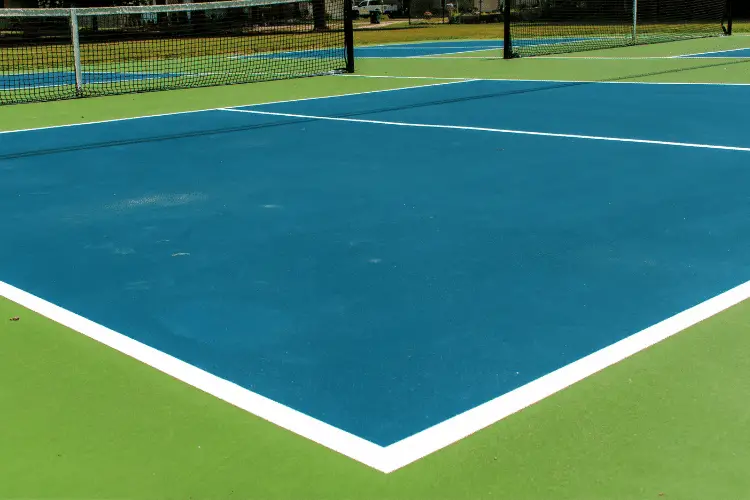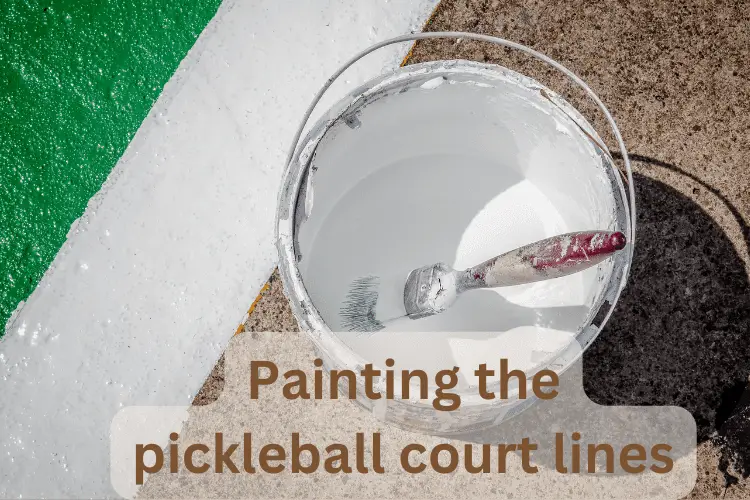“Discover how much does it cost to paint a pickleball court. Explore factors influencing pricing, from court size to paint types. Get expert insights to plan your budget accurately.”
When painting a pickleball court, the cost can vary depending on several factors. These factors include the court’s size, the existing surface’s condition, and any additional services required.
Typically, painting a pickleball court involves several steps, such as cleaning and preparing the surface, applying primer if necessary, and then applying multiple coats of paint. The type of paint used can also impact the cost.
Hiring a professional contractor specializing in sports court painting is recommended to ensure a high-quality and long-lasting result.
How Much Does It Cost To Paint A Pickleball Court?
Painting a pickleball court is a specialized task that requires precision, expertise, and quality materials. The paint and labor expenses can significantly influence the overall budget for painting a pickleball court.
The estimated cost of painting a pickleball court is $3,000 to $5,000. Nevertheless, it’s essential to note that this is a rough estimate, as the actual cost may vary depending on several factors. Let’s delve into the details to understand the critical cost determinants.

Read More: How To Make A Pickleball Rebounder? In 5 Simple Steps
How To Paint A Pickleball Court?
Prep the Surface
Before painting, ensure the court surface is clean and free of debris or loose materials. Sweep or power wash the area to remove dirt, leaves, or other obstructions. It’s also essential to repair any cracks or damage on the surface before proceeding.
Measure and Mark the Court
To ensure neat and precise lines, use masking tape to mark off the boundaries of the court. Measure and mark where each line is drawn using a measuring tape and chalk.
Apply the Primer
Applying a primer coat is crucial for better adhesion of the paint. Use a roller or sprayer to apply an acrylic-based primer evenly over the entire court surface. Allow sufficient drying time per manufacturer instructions before moving on to the next step.
Paint the Lines
Once the base coat is completely dry, it’s time to mark out the boundary lines and other markings specific to pickleball courts. Using masking tape as a guide, carefully apply white paint along each line according to official dimensions and specifications.
Add the Court Numbers
After painting the lines, it’s time to incorporate the court numbers. These numbers designate the various zones of the pickleball court, such as the “7” for the service boxes and the “2” for the back line.
You have two options for adding the numbers: employ stencils for a precise look or freehand them using a paintbrush or roller. In either case, adhering to the official pickleball court dimensions is crucial to ensure the numbers are placed accurately in their respective positions.
Protect the Court
Once the paint has thoroughly dried, it’s essential to safeguard the court from potential wear and tear. You can achieve this by applying a court coating or sealer to the surface.
Doing so will enhance the paint’s longevity and overall durability. If you desire a multi-colored court, add additional layers of paint after applying the protective coating or sealer.
Cost to Line a Pickleball Court
The price of lining a pickleball court will vary depending on the court’s size, the kind of paint used, and any other materials required. Typically, the cost of materials alone ranges from $100 to $500. There will be an additional fee for the professional’s labor services if you decide to hire them for the task.
Best Color for a Pickleball Court
Choose a suitable color for your pickleball court’s base coat. Usually, the color used for pickleball court surfaces is green or blue, although personal preference or local regulations might lead to variations in color choices. Applying at least two coats of acrylic-based paint using a roller or sprayer is recommended to achieve the best results. This ensures that the entire playing area receives even and consistent coverage.
Number of Gallons of Paint Needed for a Pickleball Court
The quantity of paint required for a pickleball court hinges on the court’s size and the thickness of the paint. As a general guideline, approximately 1 gallon of paint is typically needed.
By adhering to these steps, you can create a pickleball court that is uniform, equitable, and prepared for gameplay. Be sure to utilize high-quality paint and take time to guarantee that the lines are straight and precisely positioned.
Read More: How To Make A Pickleball Practice Wall: A Comprehensive Guide
Pickleball Court Paint Colors
The color of the court coating is a crucial aspect of a pickleball court surface.
For pickleball court coating, there are various colors to choose from. The most commonly used color is green. This choice is favored because green is gentle on the eyes and contrasts closely with the white court lines. This contrast helps players see the ball and the court lines more clearly, improving the game experience.
Another popular option is blue. Like green, blue is also promising for the eyes and contrasts with the white lines on the court. Furthermore, blue is a great color choice as it can contribute to keeping players comfortable, particularly in the hot summer months.
Gray is also a frequently used color for pickleball court coating. Like green and blue, gray is gentle on the eyes and contrasts the court lines nicely. Its neutral nature allows it to blend well with various color schemes.
Overall, the choice of color for the pickleball court coating can significantly impact the visibility and aesthetics of the court, ultimately enhancing the quality of the game.

Factors Affecting the Cost of Painting a Pickleball Court
Several factors influence the cost of painting a pickleball court. A clear understanding of these factors will enable you to estimate the budget and accurately make well-informed decisions. The following are the key elements that influence the overall cost:
Court Size and Dimensions
The size of the pickleball court is a primary consideration. Larger courts will cost more overall because they’ll need more paint and labor. The standard dimensions of a pickleball court for singles play are 20 feet wide and 44 feet long. For doubles play, the standard size is 22 feet wide and 44 feet long.
Surface Condition
The condition of the court surface is crucial. It will add to the overall cost if the court requires extensive repairs or resurfacing before painting. Before applying the paint, cracks, holes, and uneven surfaces must be made.
Type of Paint
The type and quality of paint used play a significant role in determining the cost. High-quality acrylic paint specially formulated for sports surfaces and also recommended for pickleball courts. While it may be more expensive, it offers better durability and performance in the long run.
Number of Coats
The number of coats of paint required will impact the cost. Two coats are usually necessary to achieve a vibrant and long-lasting finish.
Labor Charges
Professional painters with expertise in sports court painting may charge higher rates, but they ensure a high-quality finish.
Location
The location of the court can also affect the cost. Transportation of materials and labor expenses may vary based on the distance from the supplier and the accessibility of the location.
Additional Features
If you want to add additional features like boundary lines, logos, or custom designs, it will add to the overall cost.
Seasonal Factors
Seasonal factors can also play a role in the cost variation. Prices may fluctuate depending on the demand and weather conditions.
What Kind Of Paint Do You Use On A Pickleball Court?
When painting a pickleball court, choosing the right type of paint is crucial for achieving a durable and visually appealing surface. Several types of paint are made explicitly for sports courts, including pickleball courts. Let’s take a look at some standard options:
1. Acrylic Paint
Acrylic-based paints are frequently used for pickleball courts due to their durability and resistance to weather conditions. They provide a smooth and even finish that enhances the playing experience. Acrylic paints are available in various colors, allowing you to customize the court according to your preferences.
2. Latex Paint
Latex-based paints are another popular choice for painting pickleball courts. They offer good adhesion and flexibility, making them suitable for outdoor applications. Latex paints also provide excellent coverage and color retention over time.
3. Epoxy Paint
Epoxy coatings are known for their durability and resistance to heavy foot traffic. While commonly used on indoor surfaces, epoxy-based paints can also be applied outdoors on pickleball courts with proper preparation and maintenance.
4. Polyurethane Paint
Polyurethane coatings are known for their outstanding durability and ability to resist abrasion, chemicals, UV rays, and moisture. When used as paints for pickleball courts, these high-performance coatings create a sturdy and resilient surface that can endure intense gameplay without quickly wearing down.
Regular Cleaning And Maintenance
Regular maintenance is crucial for maintaining your pickleball court in optimal condition.
Here are some important maintenance tips:
Regularly sweep or wash the court to remove surface debris. Consider using a power washer on low-pressure settings for a thorough cleaning.
Act promptly to remove any stains that may appear on the court. Utilize a mixture of warm water and detergent to clean the stains effectively.
Conduct frequent inspections of the court’s surface to check for cracks and damage. Cracks and damage can pose safety hazards to players. If you identify any issues, ensure you promptly repair them.
Factors That Impact Court Longevity
Various factors can influence the lifespan of a pickleball court, and understanding these factors can help you maintain your court in optimal condition for an extended period.
Weather fluctuations: Extreme heat or cold weather can gradually impact the court’s surface. Using high-quality paint during the initial court painting process is essential to reduce this effect.
Traffic and usage: The frequency of court usage directly affects its wear and maintenance needs. Limiting the use of the court can significantly contribute to prolonging its lifespan.
Proper installation: The longevity of your court heavily relies on its proper installation. Hiring experienced professionals knowledgeable in installing pickleball courts is crucial to achieving the best results.
By considering these factors and taking appropriate measures, you can ensure that your pickleball court remains in top shape for an extended duration, providing you and other players with a durable and enjoyable playing surface.
Final words
Following these step-by-step instructions, you can paint a pickleball court that is visually appealing, regulation-compliant, and ready for exciting gameplay. Remember to consult local regulations or guidelines for specific requirements in your area.
How long does the paint on a pickleball court last?
The paint’s lifespan on a pickleball court varies depending on usage, weather conditions, and maintenance. On average, high-quality court paint can last anywhere from 2 to 5 years.
Can I use regular paint for a pickleball court?
Regular paint is unsuitable for pickleball courts, as sports surfaces need more durability and resistance. It is essential to use acrylic-based sports court paint for optimal performance.
Can I paint the pickleball court myself?
While it is possible to paint the court yourself, it is only recommended if you have prior experience and expertise in sports court painting. Professional painters ensure a smooth and durable finish.
Is there a specific color for pickleball court paint?
The standard color for pickleball court paint is blue or green for the playing area and red for the service area. However, some courts may have variations in color schemes.
How often should I repaint my pickleball court?
The frequency of repainting depends on factors like usage, weather exposure, and maintenance. On average, pickleball courts may need repainting every 2 to 5 years.
Can I paint pickleball court lines myself?
While painting the lines yourself is possible, it requires precision and proper measurements to ensure the court’s compliance with official regulations. Hiring professionals is recommended for accurate line markings.

